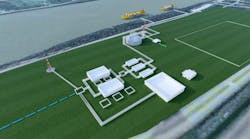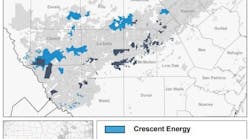Moh'd J. Al-MaslamaniField trials on flexible pipe offshore Qatar have shown that, under sour conditions, the layered, composite material can suffer severe degradation leading to failure.
Qatar General Petroleum Corp.
Doha
The failure demonstrates the significant effects of stress level, environmental aggressiveness, and localized hard zones in promoting sulfide stress cracking.
Permeability of the sour gas through the composite layer of the flexible pipe resulted in varying degrees of sulfide attack and hydrogen embrittlement, depending on the susceptibility of the multilayered material.
In the trials, the material was used as a gas-lift line in a sour-oil field in the Arabian Gulf.
Flexible pipes have been used successfully for transporting methanol, benzene, and gas condensates in wet sweet environments at temperatures of up to 80° C.
Little or no information, however, has been available as to its corrosion resistance in sour-service wells containing 6% CO2 with 3% H2S partial pressures and at moderate temperatures.
Layers
Fig. 1 [39642 bytes] illustrates the structure of flexible pipe; the various layers are high-density polyethylene (HDPE) external sheath, fabric tape, crosswound first armor, flat spiral second armor, zeta spiral reinforcement, intermediate pressure Rilsan sheath, and interlocked stainless steel type 316L carcass.
The pressure and tensile armor wires are encapsulated between an outer (polyethylene sheath) and an inner (Rilsan sheath) polymer barrier. The armor wires should remain unaffected by both sea water and the gases (CH4, H2S, and CO2) as long as the polymer barriers are intact.
A typical performance characteristic of the flexible pipe is the permeability to gases. All polymers are to some extent permeable4 to gases, the amount of permeation depending on the type of gas and the type of polymer.
In flexible pipe, permeability may allow gases to pass through the primary fluid or gas-containing layer and build-up in the interplay region. The diffusion of corrosive gases into the annulus means that the armor wires are exposed to a corrosive environment.
The mechanical properties of metallic materials become poorer in corrosive environments; therefore, diffusion into the annulus may be detrimental to dynamically loaded flexible pipes such as risers.
Described here are the trials of a 4-in. flexible pipe. The trials culminated in failure after about 3 years in service. The 4-in. flexible pipe was designed to transport dry gas lift with up to 2.5% of H2S and 6% CO2 while submerged in sea water.
In addition to the 4-in. ID, design parameters for the flexible pipe are: 6.54 in. OD, 2,175 psi (150 bar) design pressure, and 70° C. operating temperature.
Underwater survey
To locate any gas leakage and determine the extent of any damage to the line, a local subsea services carried out an underwater inspection survey of the riser and flexible flowline running between production station and oil well head jacket.
Initial findings at the riser section indicated that gas was trailing along the outer casing of the flexible flow line and escaping from three locations.
Closer inspection of the recorded survey on a video tape revealed gas seepage from four locations along the flexible flow line. Two of the gas leaks were observed on the flow line section located at 51 m for No. 4 and 50 m for No. 3, from the production station on the flow line section.
The other two locations, designated No. 2 at coordinates, N2831461, E655014.4, and No. 1 at N2831441.35, E654943.64, were 420 m and 350 m, respectively, from the well jacket of the production station, as Fig. 2 [112939 bytes] shows.
The gas seepage from the three leaking areas on the riser (Fig. 2: A, B, and C at 11.5 m, 18.5 m, and 29.5 m, respectively, from the jacket of the production station) and the flow from the leak at the 50 m area along the flexible pipeline were reduced.
Removal of a 360° band of the outer casing at 51 m out from the production station effected this reduction in gas seepage. The active direction of gas flow was from the production station towards the oil well head jacket (Fig. 2).
Monitoring of the flow line with a video camera revealed that the flow line pressure varied from 93 to 18 bar, and the rate of flow of the gas bubbles from the leaks appeared proportional to the reduction in pressure.
Divers on two different occasions surveyed location Nos. 1 and 2. During the initial survey by remotely operated vehicle (ROV), location No. 1 of the flow line (Fig. 2) was found to be 100% buried, and gas was observed to be leaking from the seabed. Divers subsequently excavated the flexible pipe, using an air lift to allow the leaking area to be monitored by video.
The flow line pressure was 24 bar, and an area of slight abrasion was noted where gas leakage was observed. No damage to the crosswound armor was visible, however, and no physical damage or distortion to the flow line was observed.
At the second survey, the flow line pressure was reduced to 5 bar. The flow of gas was considerably reduced, showing only an intermittent flow of bubbles. The area of abrasion was measured to be 170 mm x 50 mm wide; no crosswound armor was visible.
An additional area of abrasion was apparent 60 mm from the gas seepage but was reported to be less than 1 mm deep into the outer sheath with no gas seepage noted.
The initial survey of location No. 2 of the flexible pipe found the flow line to be approximately 75% buried, with the area from 9 o'clock to 12 o'clock position exposed. Gas appeared to be leaking from the six o'clock position.
Divers subsequently excavated this area using an air lift to allow the leaking area to be monitored by video. Flow line pressure was 40 bar.
No other physical damage or distortion to the flexible flow line was observed. Seabed surveys in the immediate area of Nos. 1 and 2 gas leaks revealed no indication of anchor or cable drag nor any significant items of debris.
Visual inspection
A 1-m long section of the 4-in. flexible flow line was cut at 360 m from the production station and recovered to shore for further investigation. Two bolted clamps were fixed to both ends of the section to maintain the integrity of the complete structure.
The external protection sheath made of HDPE showed evidence of slight surface abrasion. The HDPE sheath was stripped off for closer examinations of the underlying layers of the flexible pipe.
The first crosswound armor layer had one fracture in transverse direction. The second crosswound was severely corroded and had bulged out. Damaged strips were visible (Figs. 3 [25515 bytes] and 4 [24358 bytes]).
The flat spiral armor had several fractured sections along the length of the flexible pipe sample. Extensive corrosion appeared around the fractured area (Fig. 5 [27436 bytes]), and black deposits were present on an area adjacent to the fracture.
The inner zeta spiral was severely deteriorated along the length of the flexible pipe sample as a result of corrosion attack (Fig. 6 [27916 bytes]). Corrosion products as well as black deposits were observed around the area where the polyamide Rilsan layer had been damaged (Fig. 7 [39642 bytes]).
The stainless steel (Type 316L) interlocked carcass showed (Fig. 8 [19695 bytes]) general discoloration and slight corrosion attack.
Mechanical tests
Tensile test samples (200 mm long) were cut from the flat spiral, the zeta spiral, and the crosswound armor layers and subjected to tensile testing in a 200-kN testing machine. Fig. 9 [12526 bytes] shows the load-extension diagrams for the samples.
It can be seen that the maximum load, elongation and area enclosed by Curves c and d for the samples from the flat and zeta spirals, respectively, are smaller than for the samples from the first and second crosswound armors.
Table 1 [6612 bytes] summarizes the results of calculations for the tensile strength and ductility.
Samples were cut in longitudinal and transverse directions from the different layers of the pipe. These were mounted and polished with different grits down to 3 µ, then six to ten measurements were taken with a Vickers microhardness tester.
Readings were taken near as well as away from the fractured surface on the flat and zeta spiral layers. Table 2 [33504 bytes] gives the average hardness measurements and the equivalent HRC.
Metallographic exam
Several metallographic mounts of failed flexible-pipe sections were prepared.
The crosswound (first and second) armors, flat spiral armor, zeta spiral reinforcement, and the stainless steel interlocked carcass were sectioned at various locations in both longitudinal and transverse directions.
Metallographic examination of crosswound armors of the flexible pipe revealed the following:
- First crosswound armor (longitudinal direction): Small corrosion pits at the outer surface; corrosion deposits and heavily deformed and elongated grains near the outer surface and deformed grains at midsection.
- First crosswound armor (transverse direction): Small corrosion pits at surface; corrosion and heavily distorted grains near outer surface.
- Second crosswound armor (longitudinal direction): Corrosion deposits and initiation of corrosion at various locations on the surface; corrosion pits near the surface.
- Second crosswound armor (transverse direction): Corrosion deposits and initiation of corrosion on the surface; corrosion pits near the surface; heavily distorted grains near the surface.
The metallographic examination of the flat and zeta spiral wound armors of the flexible pipe revealed the following:
- Flat spiral (longitudinal direction): Initiation of corrosion at various sites on the surface; a small fine crack extending from the surface; thick corrosion deposits on the fractured surface;
Also, propagation of a crack from fractured surface; transgranular step-wise crack near the fractured surface and a few fine cracks near the main crack; heavily deformed and oriented grains around the crack; an interrupted crack near the fractured surface; and a step-wise propagation of crack.
- Zeta spiral (transverse direction): Deformed grains at the edge of the inner surface; rolling defects on the outer corner; corrosion deposits; and initiation of corrosion at different locations.
Trial results
Visual examination, mechanical testing, and metallographic examination of the flexible pipe revealed the following:
- Extensive damage appeared on the flat spiral wound when compared with the damage observed on the first and second crosswound armors, and the zeta spiral reinforcements. No corrosion was observed, however, on the stainless steel inner carcass.
- The flat armor and zeta spiral steel were brittle, as indicated by the low ductility (3.0% elongation and tensile strength of 651.4 MPa; 4% elongation and tensile strength of 651.4 MPa) value obtained compared to the design values (5% elongation and tensile strength of 850 MPa) by the tensile testing.
This is substantiated by the severely cold-worked structure in the zeta armor steel material as revealed by metallographic examination. The average hardness of the flat and zeta spiral, and the crosswound armor at several locations fall in the range 259-278 Hv (24-27 HRC) which is higher than the maximum hardness (23 HRC) specified by NACE MR0175 for sour service.
- Hydrogen-induced cracking and hydrogen embrittlement were evident along the length of the flat spiral armor. Transverse fractures as well as transverse surface cracks were observed in many locations.
The hydrogen damage was caused by the presence of H2S and CO2 (which passed through the damaged Rilsan sheath) in a wet environment in contact with the steel armor layers.
Acknowledgments
The author thanks the management of Qatar General Petroleum Corp. for encouragement and permission to communicate the results and the staff support and Qatar University for the technical support.
References
1. API Recommended Practice for Flexible pipe (RP17B), 1st Ed., June 1, 1988.
2. Chaperon, G.R., Boccaccio, H.P., and Bouvard, M.T., "A New Generation of Flexible Pipe," OTC No. 6584, Offshore Technology Conference, 1991.
3. Hill, R.T., Upchurch, John L, and McMahan Jr., James. M. "Rapid Pressure Cycle Effects on Flexible Pipe," 27th Annual Offshore Technology Conference, Houston, May 1-4, 1995.
4. S ntvedt, T., Anderson, T.R., Knagenhjelm, H.O., and Tystad, M., "Application of Materials Technology to Reduce Pipeline Costs," 29th Annual Offshore Technology Conference, Houston, May 4, 1995.
The Author
Moh'd Jassim Al-Maslamani is manager of the facilities quality assurance department in Qatar General Petroleum Corp., Doha, Qatar. He holds a BS in engineering metallurgy from Western Michigan University, Kalamazoo. He is active in SPE and NACE.
Copyright 1996 Oil & Gas Journal. All Rights Reserved.



